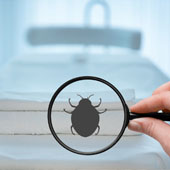
We have one-third of our life close contact with a sleeping pad that you can not thoroughly clean yourself. By natural sweating, each person loses up to 0.5 liters of fluid per night. This moisture, as well as salts and proteins contained in sweat, penetrate into the mattress and remain there. In addition, each person loses up to 1.5 g of dander per night - over half a kilo a year. These remain partly in the mattress and form the food base for dust mites. In addition, dander become infested with bacteria and mold and cause the typical, musty bedroom odor.

How was it in the past?
For centuries straw bags were used as a sleeping pad. Straw or hay were changed several times a year and the straw sack washed. The bedrooms were cold and well ventilated. The straw sacks were detached by three-piece mattresses. These could easily be taken out for beating the dust out and where they were exposed to air and sun. This was a minimum of hygiene achieved.

Mattresses nowadays
Nowadays there are a large selection of mattresses in a very good quality. Since many mattresses are unwieldy and heavy, they remain a lifetime in the bed frame, where they are hardly intercepted and ventilated. As a result, the mattresses nowadays have an significantly higher quantity of allergy triggering ingredients.

Impairment of functionality due to increasing pollution
Circulation is one of the essential functions of a mattress. It should not only form a soft base, but also ventilate our body in the sleep and provide a pleasant sleeping climate. While we sleep, we change our position several times. During these movements, dust and mite feces can escape from the mattress with the air and enter the room air. At the same time the mite excrement clogs the fine ventilation openings of the mattress over time and the sleeping comfort suffers.
![[Translate to English:] POTEMA Matratzenreinigung](/fileadmin/_processed_/3/9/csm_POTEMA_Header_Startseite_1200px_c724e090b2.jpg)